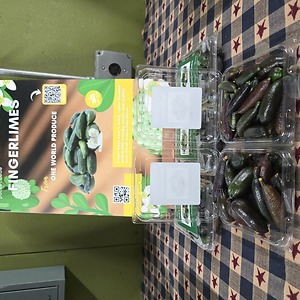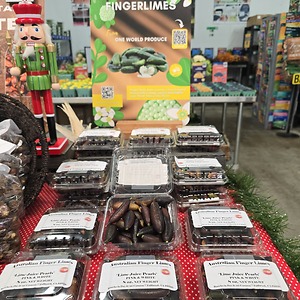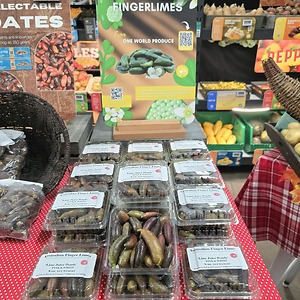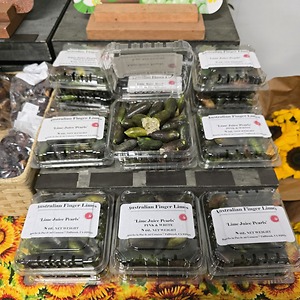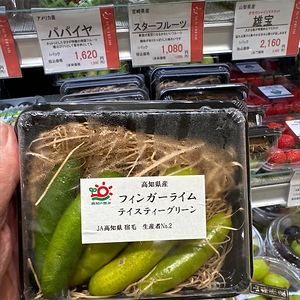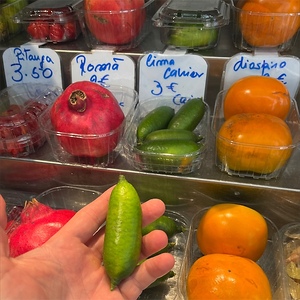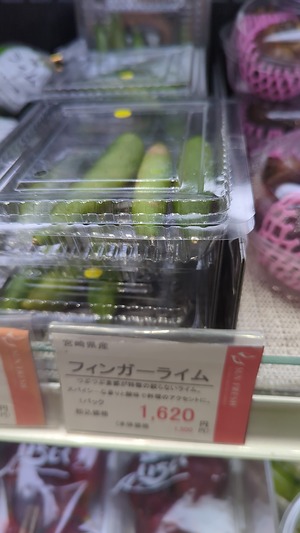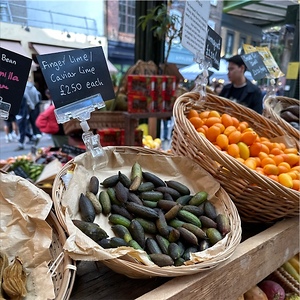


Finger Limes
Estimated Inventory, lb : 0
Description/Taste
Finger limes are small, elongated fruits, averaging seven centimeters in length, and have a narrow, oblong shape with slight tapering at both ends. The thin, taut skin is semi-smooth with a leathery, pebbled texture, and can range in color from purple, red-orange, dark green, light green, to black. Underneath the surface, the pulp consists of many small vesicles, or pearls, that are firm, slightly sticky, aqueous, and crisp, also varying in color from pink, pale green, to white. When consumed, the pearls create a popping, snap-like sensation with a burst of sweet-tart flavors. Finger limes bear a minty, citrus-forward aroma with a tangy, sweet, and slightly sour, floral, lemon-lime flavor.
Seasons/Availability
Finger limes are available for limited a time during the late summer through early spring in select regions of Australia and the United States.
Current Facts
Finger limes, botanically classified as Citrus australasica, are varieties of microcitrus that belong to the Rutaceae family. The slender, finger-like fruits have been nicknamed the “caviar of fruit,” and are globally sought after for their bright flavor and unique popping consistency. Despite their recent rise to fame among high-end chefs, Finger limes are an ancient fruit that has been utilized for thousands of years in Australia. There are over six genetically diverse varieties found in varying sizes and colors. In the modern-day, Finger limes are rarely found growing naturally due to past deforestation. The fruits remain relatively rare and are cultivated through limited commercial production in sub-tropical and tropical regions.
Nutritional Value
Finger limes are an excellent source of vitamin C, which is an antioxidant that strengthens the immune system and helps to reduce inflammation. The fruits are also a good source of vitamin E, a nutrient that protects the body against environmental damage, and contains folate and potassium.
Applications
Finger limes are utilized as a fresh garnish and can be incorporated into both raw and cooked preparations. The limes can be sliced in half, gently squeezed or scooped to extract the pearls, and layered over tacos, grain bowls, green salads, and fruit salads. The pearls can also be sprinkled over sliced avocado or melons with sea salt as a fresh snack. Finger limes are frequently used by chefs to brighten and complement the flavor of seafood such as grilled salmon, oyster shooters, seared scallops, sushi, nigiri, and ceviche. Bakers also favor the acidic pearls for marmalades and use them to decorate cheesecakes, ice cream, cookies, cakes, and cream puffs. Beyond culinary purposes, Finger limes are used as a floating garnish on cocktails and spirits such as mojitos, margaritas, martinis, and gin fizz. Finger limes pair well with fruits such as watermelon, persimmons, melons, and avocadoes, leafy greens, ginger, feta cheese, rice, tofu, and poultry. Fresh limes will keep for 2-4 weeks when wrapped in plastic and stored in the refrigerator. They can also be frozen whole and stored for 6-12 months in the freezer.
Ethnic/Cultural Info
In Eastern Australia, Finger limes are nicknamed “rainforest pearls,” as the slender fruits are native to the tropical rainforests of Queensland and New South Wales. In ancient times, the indigenous peoples of the Bundjalung, Gumbainggir, Wakka Wakka, and Barunggam nations would use Finger limes as a medicinal aide to prevent illnesses and apply the pearls topically as an antiseptic. These nations also considered the Finger limes as “bush tucker,” which are wild fruits that have been traditionally foraged as a primary source of food.
Geography/History
Finger limes are native to Australia, specifically to the rainforests in Southeast Queensland and Northern New South Wales. In ancient times, the small fruits grew naturally in the wild, but when European colonization arrived, deforestation for settlements and farming almost destroyed the entire species. Some Finger lime varieties survived on farmland and private property, and these trees are the source for the commercial trees used in production today. In 1966, Dr. Joe Furr donated Finger lime budwood from Australia to the University of California, Riverside, for trials of rootstock, and the university later allowed for the budwood to be sold for commercial production. Today Finger limes are primarily grown in Australia. It has been reported that over fifty percent of the country’s Finger lime harvests are exported to Asia and Europe, while the remaining half are sold locally. Outside of Australia, the fruits can be found at farmers markets and specialty grocers in select regions of the United States.
Recipe Ideas
Recipes that include Finger Limes. One



